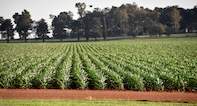Maize is susceptible to various pests, depending on the plant variety, production practices and environmental and climatic conditions.

Most farmers use integrated pest management to prevent pest damages, which may entail the use of crop rotation, cover crops and conservation farming practices to break disease and pest cycles, improve soil health and in effect plant resilience as well as the water holding capacity of the soil. These practices also create a favourable habitat for beneficial organisms and insects that may help to keep problem creatures in check.
Besides this, farmers may plant maize varieties that are resistant or more tolerant or has a short growth length to reduce the threat of specific pests in their production region. They may also use pesticides, but should use these judiciously and according to instructions to prevent the development of pesticide resistance.
Locusts Agricultural Pests
Pest management in maize production includes, Locusts that are one of the world’s most notorious agricultural pests, with swarms eating everything that comes in their way.
The biggest culprit is desert locusts, which at the start of 2020 caused huge crop losses and devastation with swarms as big as cities in East Africa, South Sudan and South East Asia.
In their non-swarming phase, desert locusts are restricted to the arid and semi-arid areas across a broad belt of the Sahra and Sahel region of Africa, reaching across the Arabian Peninsula into north-west India.
They can, however, cover vast distances, with a swarm flying from northwest Africa to Great Britain in 1954 and trekking from West Africa to the Caribbean in 1998, according to National Geographic.
Desert locust invasions are nevertheless a low threat to South Africa, with no historical records of previous invasions. The situation is nevertheless monitored and the country is ready to act based on past experiences with local species, should an outbreak occur.
Pest management in maize production in South Africa’s main threats are red and brown locusts with the brown locust, which is endemic to the Karoo, having the most significant impact on agricultural production.
Brown locust swarms may develop every seven to eleven years, usually developing during wet conditions following a drought, because their eggs can survive up to four years in a drought.
A swarm can be 460 square miles in size and pack between forty million to eighty million locusts into less than half a square mile, according to National Geographic.
An adult locust will eat his body weight in plants each day, on average consuming 450 grams of dry matter a day. According to the Department of Agriculture, 3 4000 adults will consume the same quantity of grazing as a 50 kg dorper ewe.